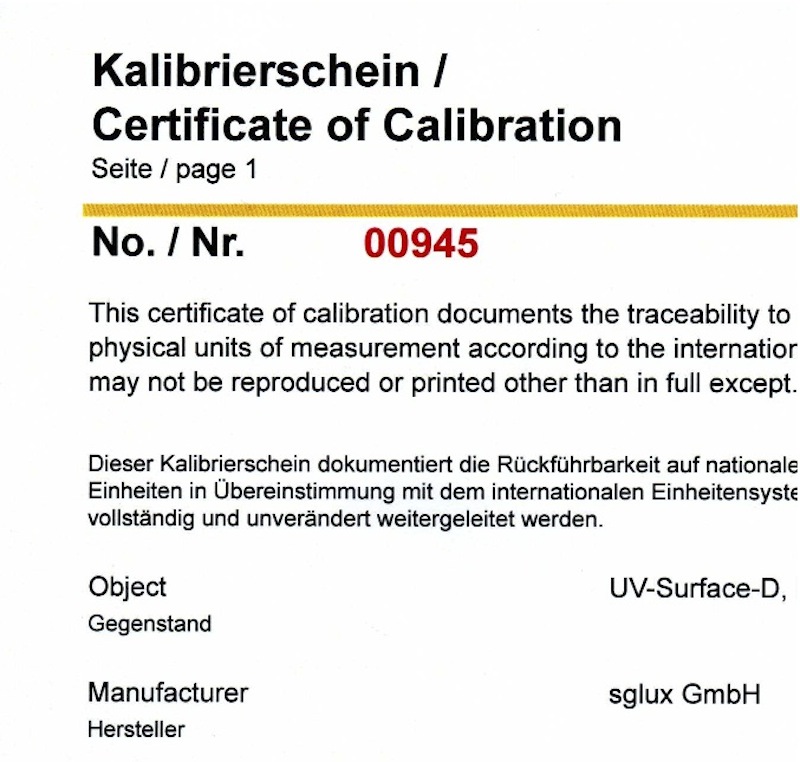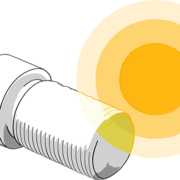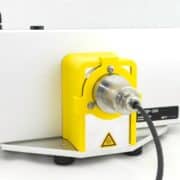UV Calibration

- Calibration service according to guidance
DAkkS 71 SD 0 025 and DIN/ISO 17025 - Wavelength range: 200 nm to 430 nm
- Traceable to the PTB (National Metrology Institute)
- Calibration of UV sensors on different UV sources or supplied UV lamps (sensitivity regarding the irradiance W/m²)
- Spectral response measurement of UV sensors (A/W/nm, V/W/nm, counts/W/nm)
- Irradiance measurement on UV sources (W/m²/nm)
- Determination of the angle dependent sensitivity of sensors in use with different UV lamps
What is calibration?
Calibration is the determination and documentation of a mismatch between the measurement values of a measuring device and those of a calibration standard. In order to transform the measurement signal (usually electric current) in a signal based on SI units, the calibration factor is determined. After the calibration the calibration factor will be directly applied to the measurement device or the regulator (e.g. a potentiometer) will be adjusted if possible. It is called a traceable calibration if a standard device of known accuracy is used for the calibration and the measurement error is determined (according to GUM= Guide to the Expression of Uncertainty in Measurement (http://www.bipm.org/en/publications/guides/gum.html)). The standard device is related to a national primary standard which is characterized by the PTB or another accredited laboratory. The definition of the SI-unit is contained therein.
How does a calibration laboratory work?
A calibration is done under controlled conditions in a calibration laboratory. Trained personnel as well as an efficient infrastructure and the appropriate measurement technology should guarantee good professional practice.The calibration of a wavelength-integrating UV radiometer is only valid for a combination of UV probe and UV radiation source, since the signal from the radiometer is proportional to the convolution of the spectral sensitivity of the probe with the spectral emission of the source. Consequently the irradiance of the UV source is always measured with a traceable-calibrated spectroradiometer (W/m²/nm) or a UV radiometer (W/m²) before calibration. In order to reduce the measurement error caused by different field of views, the input optics of the sensor and the reference system should be nearly equal. In case of a calibration with a UV radiometer, the spectral response of the radiometer has to be equal to the spectral response of the sensor. Optical filters realize weighting functions like the erythemal action spectrum (UV-Index sensors) or the microbicidal action spectrum (DVGW/ÖNORM sensors). When using a spectroradiometer, the irradiance will be determined by integration over the selected wavelength range. A weighting function (erythemal action spectrum, microbicidal action spectrum, ICNIRP) can be applied. sglux uses reference radiometers, calibrated spectroradiometers and calibration standards for calibration. In order to ensure the quality of the calibration process, the calibration standards are traceable to the national calibration standards supplied by the PTB.
Our services
Our calibration service includes the following measurement values:
• sensitivity regarding the spectral irradiance (sE in [W/m²])
• spectral response of UV detectors (sE(λ) in [A/W/nm])
• spectral irradiance of UV sources (E(λ) in [W/m²/nm])
• determination of the angle dependent sensitivity sE(θ) of UV sensors
The following measurement devices are used for calibration:
• calibrated spectroradiometer Gigahertz BTS2048-UV-S-F, calibrated measurement range: 200-430 nm
• calibrated reference radiometer (DVGW, ÖNORM)
• calibrated current sensors (e.g. sglux UV-Surface), the current is measured by a calibrated Keithley 6514 Electrometer
The following UV sources are available:
• mercury low pressure lamp
➢ UVA: PL-L 36W-09 (Emission Peak 365nm), PL-S 9W BLB, 40W Q-LAB UVA340 (Emission Peak 340nm)
➢ UVB: PL-L 36W-01 (Narrowband, Emission Peak 311nm), PL-S-9W-12 (Broadband)
➢ UVC: PL-L 36W (Emission Peak 254nm)
• mercury medium pressure lamp: 1 kW undoped (irradiance approx. 1000 mW/cm²)
• mercury medium pressure lamp: calibration standard developed in cooperation with the PTB (calibration of DVGW/ÖNORM sensors)
• microwave powered mercury medium pressure lamp: UV Fusion I300 with an undoped Ga or a Fe doped source
• TEC-UV-LED Arrays (TEC thermo-electric-cooled):
➢ UVA:
7 x 405nm (Nichia), max. radiant power approx. 10W
7 x 395nm (Nichia), max. radiant power approx. 10W
7 x 385nm (Nichia), max. radiant power approx. 10W
7 x 365nm (Nichia), max. radiant power approx. 10W
➢ UVC/UVB:
5 x 285nm (Nikkiso), max. radiant power approx. 200mW
5 x 280nm (Nichia), max. radiant power approx. 200mW
5 x 280nm (Nikkiso), max. radiant power approx. 200mW
5 x 275nm (Vishay), max. radiant power approx. 100mW
5 x 265nm (Stanley), max. radiant power approx. 100mW
• USHIO 12W KrCl-Excimer 222nm UV lamp
• 30 W Deuterium UV lamp, calibrated by PTB
• FEL 150W Tungsten halogen lamp, calibrated by PTB
• 75W Xenon lamp
• sun: Berlin, Adlershof 52° 26′ 16″ N, 13° 32′ 51″ O: clear sky May – September (UVI > 4), calibration in winter is possible with additional cost at a measurement station in Malaga (Spain)
Calibration process
Calibrations are performed after determination of the customer’s requirements, the field of application and the specific environmental conditions. Please see diagram below.

Your request
The requirements for a proper calibration by sglux are listed below:
• Appropriate measurement devices for the calibration have to be available or supplied by the customer, which is always the case for sglux products.
• The UV source with the necessary irradiance should be available or supplied by the customer. Therefore UV LEDs can be acquired by sglux. In case of very high irradiance, a calibration on site could be useful.
• The calibration of UV Index sensors depends on the weather and the season. A calibration in Berlin is possible from May – September.
To ensure a fast order processing, we recommend to use our request for calibration form for your calibration demand. For specific requests we invite you to call our experts via telephone to talk about your calibration.
The measurement
Once we have received your order or devices, the measurement takes place under the defined conditions. The calibration object acclimates in our laboratory and the UV source will be stabilized. In order to determine the measurement values of the sensor, the irradiance will be measured with a calibration standard and with the sensor. The values will be compared to adjust the sensor. The measurement uncertainty is improved by averaging various measurements.
The documentation
The documentation is done according to DAkkS 71 SD 0 025. The description of the calibration object (serial number, manufacturer), a description of the measurement method and the environmental conditions as well as the measurement values and the measurement uncertainty are included in the certificate.
The typical lead time for a calibration is two weeks after clarification of technical details and, if necessary, the consignment of detectors or emitters.
Below, as an example, some calibration procedures are presented.
Showing all 8 results
-

UV-Calibration, Irradiance
calibration service, calibration of UV sensors, irradianceProduct Description- irradiance calibration of UV sensors for measurements with specific UV sources
- incl. calibration certificate according to guidance DAkkS 71 SD 0 025 and ISO 17025
- Prices for calibrations of third-party devices on time and material basis.
-

UV Calibration, certified sensors for water disinfection
calibration service, calibration of a UV sensor acc. to DVGW W 294-3:2006 / ÖNORM M 5873 / DIN 19294Product Description- calibration of a UV sensor for certified water disinfection
- incl. calibration certificate according to DVGW W 294-3:2006 / ÖNORM M5873 / DIN 19294
-

UV-Calibration, UV Index
calibration service, calibration of UV Index sensors in the sunProduct Description- calibration of sglux UV sensors for UV Index measurements in the sun
- incl. calibration certificate according to guidance DAkkS 71 SD 0 025 and ISO 17025
- Prices for calibrations of third-party devices on time and material basis.
-

UV-Calibration, Spectral Responsivity
calibration service, determination of the spectral responsivity of photodiodes and probes, 200nm…600nmProduct Description- determination of the spectral responsivity of photodiodes and probes, 200nm…600nm
- incl. calibration certificate according to guidance DAkkS 71 SD 0 025 and ISO 17025
-

UV aging analysis
UV aging analysis on UV photodiodes or UV sensors or other objectsProduct Description- analysis of up to four UV photodiodes or UV sensors or other objects behavior under strong UV radiation
- determination of the spectral responsivity before and after the UV aging process
- continuous monitoring and storage of the probe output
- UV radiation up to 130 mW/cm² and temperatures up to 350°C
- 100 hours of irradiation time
- incl. report
-

UV transmission measurements
UV+VIS transmission measurements of windows, filters, diffusers and textilesProduct Description- UV-Vis transmission measurements between 190 – 1100 nm with dual-beam spectrometer Shimadzu UV-1900
- Photometric range -4 to 4 absorption units
- Scattered light contribution at 220 nm <0.02%
- Sample size up to 50 x 50 mm²
- Holders can be designed and 3D-printed according to customer requirements
- incl. laboratory report and data as csv text file
- Single price is for setup and one measurement. Each additional measurement will cost 25€.
-

UV-REF-LED
Tool for PTB traceable calibration of UV sensorsProduct Description- Tool for PTB traceable calibration of UV sensors, consisting of
- current and temperature stabilized UV LED array
- precise sensor holder
- PTB traceable transfer standard
-

UV-Arc Validation Set
222nm Source and Reference Radiometer for arc detecting UV sensors according to EN 50317Product Description- 222nm Source and Reference Radiometer for arc detecting UV sensors according to EN 50317 consting of:
- current and temperature stabilized KrCl 222nm reference source
- UV Radiometer SXL 55 as display unit
- UV-Arc reference sensor

